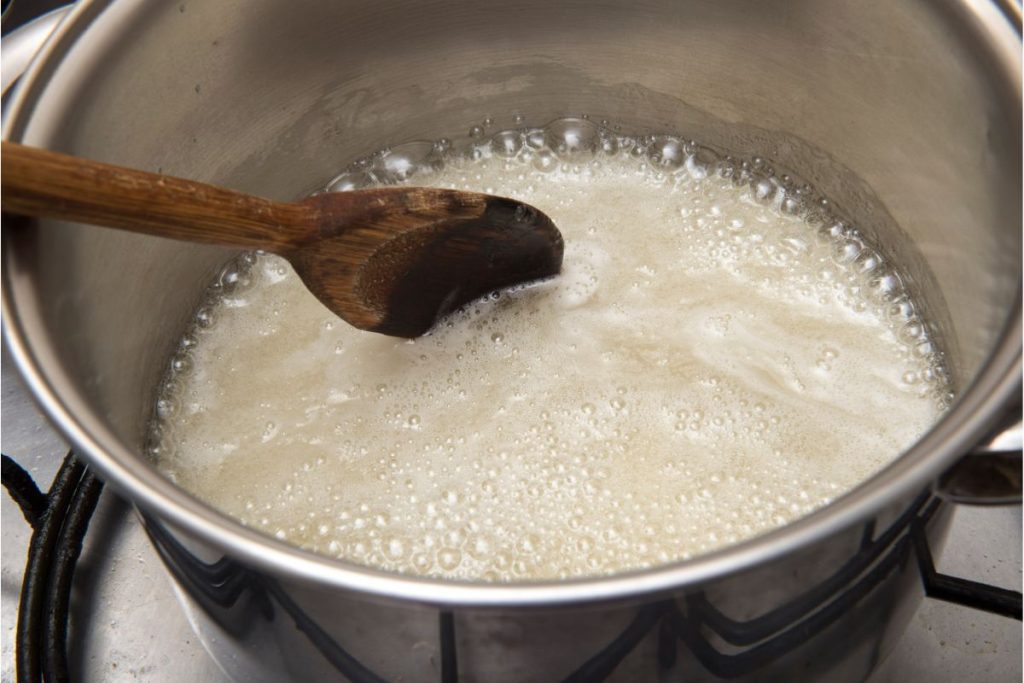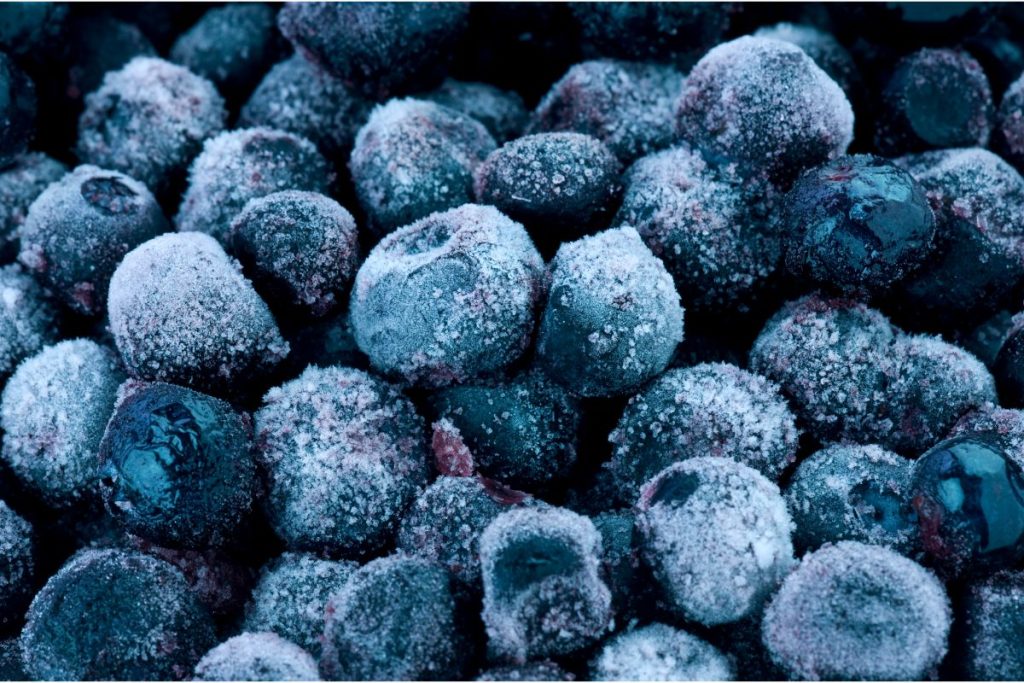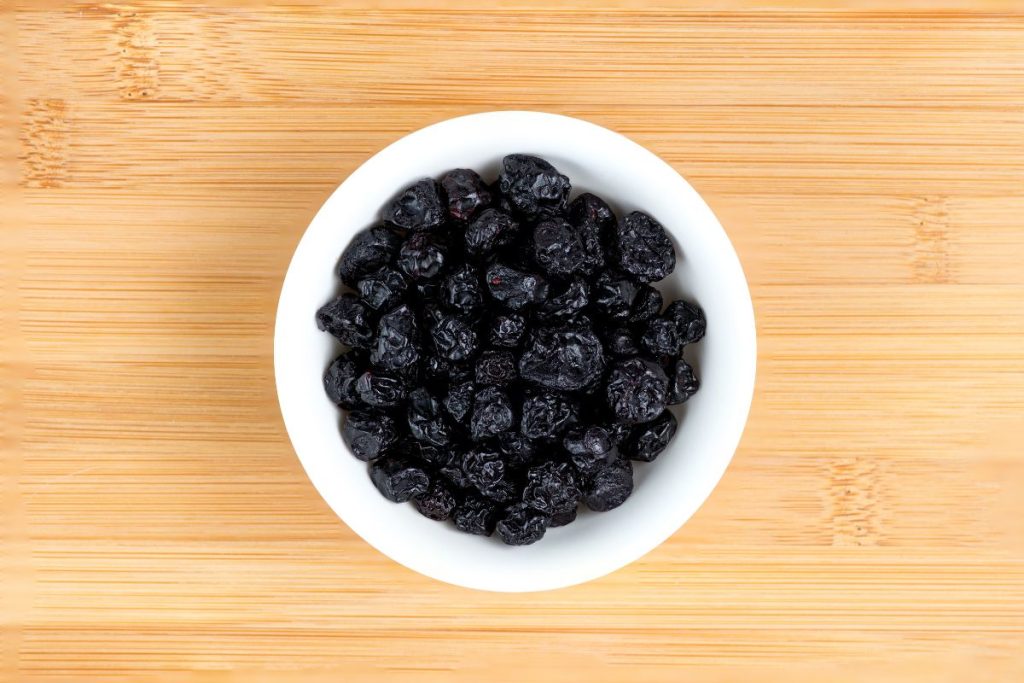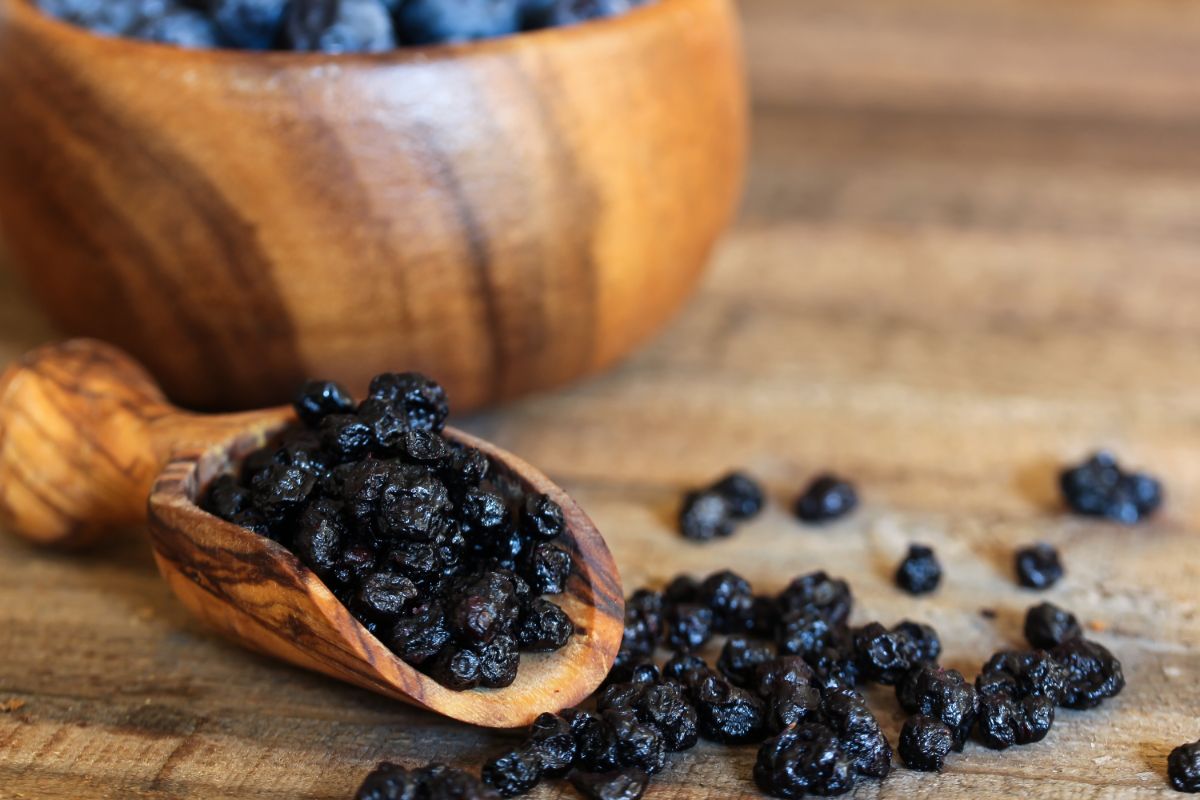Before dehydrating blueberries in a food dehydrator, wash them and blanch them in boiling water or a simmering sugar syrup solution. Cool the heat-treated berries in ice water and arrange them on screened dehydrator trays to dry for 8-18 hours at 135°F.
Table of Contents
Why You Should Blanch Blueberries Before Drying Them
Blueberries have tough skins and require blanching before dehydration. This simple food preservation procedure is important for the following reasons:
- Blanching shortens the drying time for blueberries as the cracked skins allow heat and moisture to pass through freely.
- It helps preserve flavor and color.
- It prevents case hardening. Case-hardened berries dry deceptively; the skin hardens and dries faster than the interior, which retains moisture.
- It removes the natural waxy film or coating on the blueberries.

How to Blanch Blueberries for Dehydrating
Blueberries can either be blanched in boiling water or a sugar syrup solution. Both methods will split the skin of the blueberry to ensure adequate drying.
Blanching Blueberries in Water
Water-blanching is the easiest and most common method of blanching, but it also can result in soft fruit.
Here’s how to blanch blueberries in water:
- Wear disposable gloves before you start the blanching process. The berries may juice out during handling and stain your skin for 1-2 days.
- Remove any stems and leaves. Put the berries in a blanching basket, colander, or mesh strainer and wash them under cold running water. Drain the water and pat the berries dry with paper towels.
- Dip the blueberries in boiling water for 25-30 seconds. Use enough water to fully submerge the berries. For example, for 5 cups of berries, use at least 7 cups of boiling water.
- Use a slotted spoon, strainer, spider skimmer, or stainless steel sieve to remove the enlarged berries from the hot water.
- Dip the berries immediately into ice water for up to 1 minute. The sudden temperature change will cause the skins of the berries to crack.
- Remove the berries and lay them on paper towels. Pat them dry with the towels or let them air dry for 1-2 hours before dehydrating them.

Blanching Blueberries in Sugar Syrup
Syrup-blanching blueberries is the better option for keeping the berries firm. Follow these steps to blanch blueberries in sugar syrup:
- Make a syrup solution with one part sugar and two parts cold water.
- Heat the solution to a simmer on a stovetop.
- Once the solution is bubbling, plunge the blueberries into the syrup and allow them to simmer for 2 minutes.
- Use a slotted spoon to remove the berries and submerge them in an ice-water bath.
- Remove the berries from the ice water after 2 minutes and lay them on paper towels. Pat them dry, then dehydrate them.

Can Blueberries Be Frozen to Crack Their Skins?
An alternative to blanching is freezing fresh blueberries for 1-2 days. Freezing will expand the berries and make the skins crack. Dehydrate frozen blueberries immediately, even without thawing them first.

How to Dehydrate Blueberries in a Food Dehydrator
Dehydrating blueberries in a food dehydrator is the best method as it reduces the chances of burning the berries. Follow these step-by-step instructions to dry blueberries in a dehydrator:
- Select the best fresh blueberries for drying. Choose firm ones with an even blue-black or purple-blue color.
- Remove any stems and leaves that may be attached to the berries. Wash blueberries in a colander with cold running water for a few minutes. Drain the water and pat the berries dry with paper towels.
- Blanch the blueberries in boiling water or simmering sugar syrup.
- Arrange the blueberries on screened dehydrator trays in a single layer, leaving enough spaces between them to promote aeration. If you don’t have screens or mesh trays for your dehydrator trays, line them with parchment paper or fruit leather sheets to avoid sticking.
- Place the loaded trays in the dehydrator and dry the blueberries at 135°F for 8-18 hours. Dry the berries until they are chewy or leathery.
- Rotate the trays and begin monitoring the drying process after 6 hours.
- Once you notice considerable shrinking, cool a few berries to room temperature. Test them for dryness. They should be chewy, pliable, leathery, or crunchy.
- Remove the dry blueberries and cool them to room temperature.
- Keep the dry berries in plastic or glass Mason jars and condition them for 7 days at room temperature in a cool, dry, dark place. Shake each glass jar daily. Re-dehydrate any containers of berries that show signs of moisture or clump together inside the jar.
- Transfer the conditioned blueberries into airtight storage containers and keep them in a cool, dry, dark place at room temperature.

How Long Does It Take to Dehydrate Blueberries?
It takes 8-18 hours to dehydrate blueberries in a food dehydrator. The actual drying time depends on the size of the berries, their water content, the type of food dehydrator, the humidity in the drying room, and the blanching method used.
Blueberries blanched in sugar syrup take 12-18 hours to dry, while water-blanched blueberries take 8-15 hours to dry. The total time includes the drying time, a prep time of 10-15 minutes, and the cooling time before conditioning and long-term storage.
What Type of Dehydrator is Best for Dehydrating Blueberries?
It’s best to use a horizontal airflow food dehydrator to dry blueberries. Horizontal flow dehydrators have better air circulation and dry fruits more evenly.
Ways to Use Dehydrated Blueberries
Dehydrated blueberries are highly nutritious fruits ideal for various recipes:
- Add them to a blueberry trail mix
- Chop and add them to baked goods like blueberry muffins
- Homemade blueberry granola bars
- Jazz up oatmeal and make blueberry oatmeal cookies
- Rehydrate them and blend them into smoothies
- Yummy blueberry pancakes, anyone?

How to Store Dehydrated Blueberries
Dehydrated blueberries should be stored in labeled airtight containers at room temperature in a cool, dry, dark place. Glass containers are the best for storing dried blueberries since glass doesn’t react with the acid in the berries.
Vacuum-sealed Mylar bags and freezer bags are also ideal for both room temperature and cold storage.
Shelf Life of Blanched and Dehydrated Blueberries
Dehydrated blueberries that have been blanched have a shelf life of 6-12 months at room temperature in airtight containers.
Blanching increases the shelf life of dehydrated foods like blueberries by inactivating enzymes and reducing contamination on the surface of the food. Always blanch blueberries before drying them for the best results.

